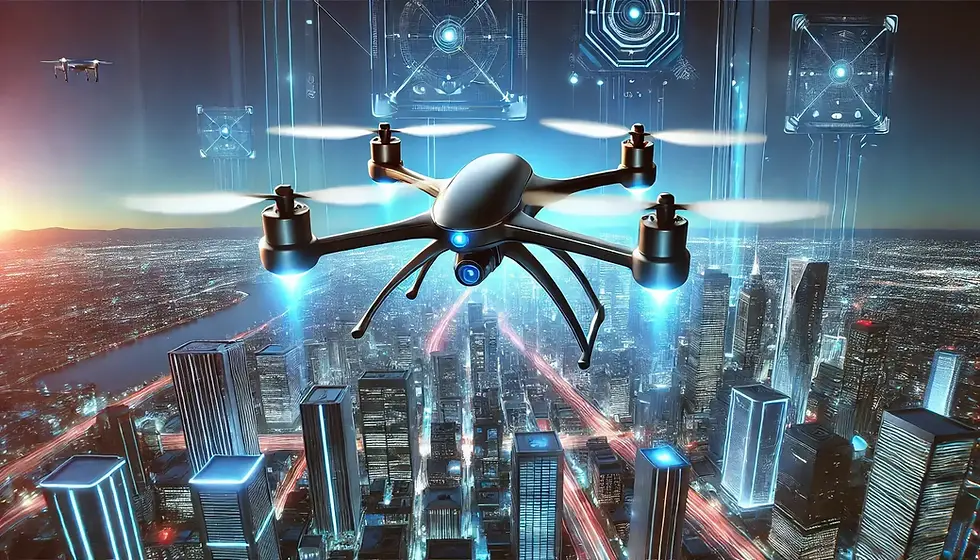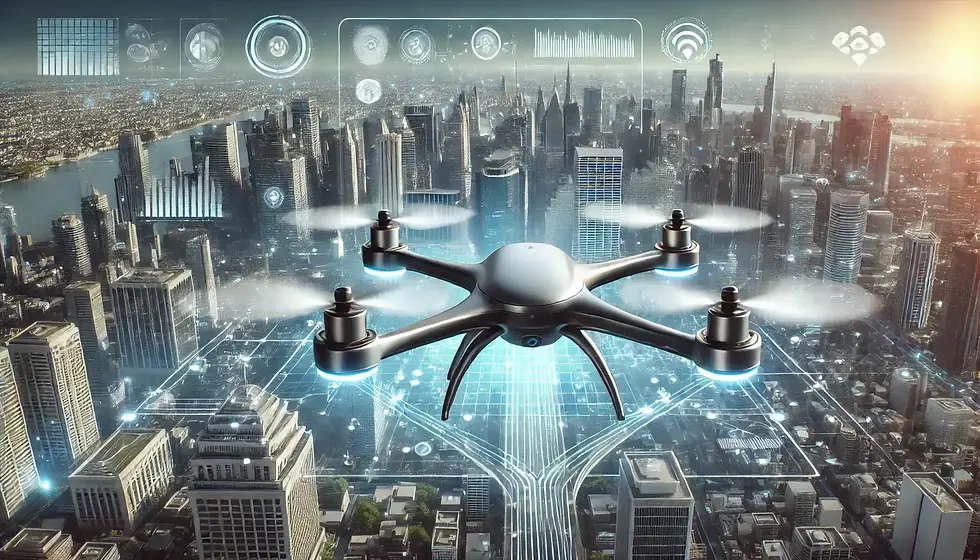Drones: How They Work and the Technology Behind Them
- Kalyan Bhattacharjee

- Mar 27
- 3 min read
Updated: 4 days ago

Let's Dive In | Drone Tech
Drones, also known as unmanned aerial vehicles (UAVs), have revolutionized various industries, from military defense to agriculture and entertainment. These aerial machines operate without a human pilot on board and are controlled either remotely or autonomously through AI-based navigation systems.
In this blog, we will explore how drones work, their core technologies, and their applications in modern society.
How Drones Work | Drone Tech
Drones function using a combination of propulsion systems, navigation technology, sensors, and communication links.
The main components of a drone include:
Propulsion System: Drones use electric motors powered by lithium-ion or lithium-polymer batteries. Larger UAVs may use fuel-powered engines.
Flight Control System: This system includes gyroscopes, accelerometers, and onboard computers that stabilize and control the drone’s movement.
GPS & Navigation Module: Global Positioning System (GPS) allows drones to determine their exact location and follow predefined flight paths.
Communication Link: Drones use radio frequency (RF) signals, Wi-Fi, or satellite communication to send and receive commands from the remote pilot or an autonomous control system.
Sensors & Cameras: Advanced drones are equipped with infrared cameras, thermal sensors, LiDAR, and obstacle-avoidance systems for real-time data collection and navigation.
ESC (Electronic Speed Controllers): Adjusts motor speed based on control signals. ESCs ensure each motor responds accurately to flight commands, helping maintain stability and control during maneuvers. They play a crucial role in smooth takeoff, hovering, and directional changes.
The Technology Behind Drones
Modern drones rely on a combination of advanced sensors, AI systems & communication technologies to fly safely and perform complex tasks. Here’s a quick look at the core tech that powers them.
Autonomous Flight Technology
Some drones can operate autonomously using AI algorithms that process sensor data to make real-time decisions. This allows them to fly predefined routes, avoid obstacles, and complete complex missions with minimal human intervention.
Computer Vision & Machine Learning
Drones equipped with AI-powered cameras can recognize objects, track movements, and analyze terrain. These capabilities make them ideal for tasks like surveillance, agriculture monitoring, and wildlife tracking.
LiDAR (Light Detection and Ranging)
Used for 3D mapping, navigation, and obstacle detection. LiDAR helps drones build precise spatial maps, enabling highly accurate positioning even in low-light or GPS-limited environments.
5G Connectivity
Enhances real-time data transmission, improving the accuracy and responsiveness of drones in various applications. With lower latency and higher bandwidth, drones can stream HD video, send sensor data instantly, and operate more reliably over long distances.
Swarm Technology
Multiple drones can operate in coordination using AI, beneficial for search-and-rescue missions and military operations. Swarm intelligence enables drones to communicate, share data, and execute tasks collectively, improving efficiency and coverage.
How Drones Stay Stable: Role of the IMU & PID Algorithm
Most people don’t know how drones hover or stay balanced mid-air:
Drones use PID (Proportional-Integral-Derivative) controllers to continuously adjust motor speeds and stabilize flight.
The IMU sends orientation data (roll, pitch, yaw) to the flight controller every few milliseconds.
This data loop allows real-time adjustments - just like a tightrope walker constantly correcting posture.
Types of Drone Communication Protocols 📡
There are multiple communication protocols and frequency used by drones:
Protocol | Use Case | Frequency Band |
2.4 GHz RC | Standard controller signal | 2.4 GHz |
5.8 GHz FPV | Live video transmission | 5.8 GHz |
DJI OcuSync | Proprietary low-latency video | 2.4/5.8 GHz combo |
LTE/4G/5G | Long-range autonomous missions | Cellular networks |
Applications of Drones In Real-World
Military & Defense: Surveillance, reconnaissance, and targeted strikes.
Agriculture: Crop monitoring, pesticide spraying, and soil analysis.
Logistics & Delivery: Companies like Amazon and UPS are exploring drone-based package deliveries.
Aerial Photography & Filmmaking: Used in media, cinematography, and event coverage.
Disaster Management: Drones help in search-and-rescue missions and assessing damage after natural disasters.
Urban Planning & Construction: Surveying land, inspecting infrastructure, and improving city planning.

Wrapping Up
Drones continue to evolve with advancements in AI, battery technology, and communication systems. As regulations improve and technology advances, UAVs will become an even more integral part of everyday life. From commercial applications to humanitarian efforts, drones represent a major shift in how we interact with technology and the world around us.
Disclaimer: This article is for informational and educational purposes only. Always follow local laws and regulations when operating drones or using related technologies. Unauthorized drone activity or interference with airspace is strictly prohibited.
Related Keywords: unmanned aerial vehicle, uav meaning, drone what is, when was the drone created, who invented the drone, what is the drone technology, what is anti drone technology, latest drone technology, drone technology, what are military drones, drone detection, tech drone, drone tec, drone technical, drone tech, anti drone tech, high tech drones, fintech shield







Comments